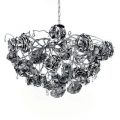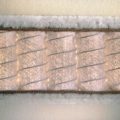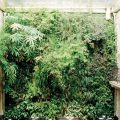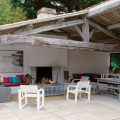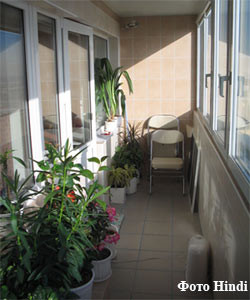 Light for plants Window facing west andeast, are almost equally illuminated, only at different times of the day, and practically do not require shading. For some reason, many people have a strange attitude to the northern windows, some even believe that they can not grow plants at all, it is not. There are a lot of plants (some of which we will give below) that grow well on northern windows, moreover, there are cases when cacti were grown on northern windows (and they are known to be light-loving), and they not only grew beautifully, but even blossomed . The larger the window, the more light the plants receive, the closer the plants are to the window, the better their illumination. For any arrangement of windows, you should not shade them with thick curtains (if the description of the plant is about shading, then a tulle curtain is enough, you can use a mosquito net if the plant is on the windowsill). Here is a list of plants most suitable for a window on either side of the world. But do not be surprised if you find the name of the same plant on the north and south window. There are plants that are very undemanding and can grow, and even bloom, on any window, unless, of course, other conditions are observed (for such plants, for example, passionflower).
Light for plants Window facing west andeast, are almost equally illuminated, only at different times of the day, and practically do not require shading. For some reason, many people have a strange attitude to the northern windows, some even believe that they can not grow plants at all, it is not. There are a lot of plants (some of which we will give below) that grow well on northern windows, moreover, there are cases when cacti were grown on northern windows (and they are known to be light-loving), and they not only grew beautifully, but even blossomed . The larger the window, the more light the plants receive, the closer the plants are to the window, the better their illumination. For any arrangement of windows, you should not shade them with thick curtains (if the description of the plant is about shading, then a tulle curtain is enough, you can use a mosquito net if the plant is on the windowsill). Here is a list of plants most suitable for a window on either side of the world. But do not be surprised if you find the name of the same plant on the north and south window. There are plants that are very undemanding and can grow, and even bloom, on any window, unless, of course, other conditions are observed (for such plants, for example, passionflower).
North windows
There are many beautiful indoor plants,which need diffuse light and therefore are well suited for placement on or near the northern window. To the flowering plants of the northern window, you can include the city of Senpia, or the Umbrian violet, exotic hybrids of the anthurium Scherzer, cyclamen, Kalanchoe. Suitable for this and hybrid species of begonias, for example begonia Lorren. If there is enough space on the windowsill, you can place on it an unpretentious, but beautifully flowering passionflower, which though light-loving, but will bloom on the northern window (after flowering it is cut off). Most bromeliads will also grow well on the northern window. Near the window you can place some palm trees, for example a beautiful hoveju or a date Lorer. On the northern window, it is necessary to take into account the temperature difference, that is, plants standing in warmer rooms tend to need more water than plants in cooler rooms. Plants for the northern window: Aglaonema, adiantum, aspidistra, asparagus, aucuba, , biota oriental, gelksina, dracaena bordered, dracena fragrant, zigokaktus, saxifraga, calanchoe, red carapagata, large-lipped ragwort (not variegated), Japanese ligodium, monstera, arrowroot, peppermia gray olistnaya, nightshade, ferns, ivy, passion flower, sansevieriya, Epipremnum, spatifillyum, Selaginella, Tolman, fatskhidera, Fatsa, dwarf ficus, philodendron scansorial, Fitton, tsissus rombolistny, cineraria.
South Windows
Growing plants on the southern window is more troublesome thanon the northern, as few plants endure a prolonged exposure to direct sunlight. Often at the hottest time of the day you have to create a shading, in the form of a gauze or veil. It is inconvenient that when you are at work, there is nobody to do this and the plants can suffer. Therefore, you need to carefully select plants on the windowsill of the southern window. On the window sill itself you can place only the most resistant and sun-hungry plants, for example cacti and other succulents, hoya fleshy, stephanotis blooming, passiflora, etc. If you read in the recommendation for plant care that it is photophilous, but needs shading , then place it on a table near the southern window under the protection of the curtain. Such a place is ideal for such decorative-deciduous flowers as cyperus, hamerops, cissus, koleus and evergreen myrtle. Plants for the southern window: Indian azalea, aloe tree, Aloe Hanburian, bovardia, jasmine Sambak, Japanese camellia, Wheeze Blume, mammillaria, prickly pear, cleansing, Chinese livistone, plectrant, fuchsia, haworthia, hoya, cerium, echinocactus.
East Windows
On the eastern windows there is much less illumination,than on the southern, and it differs in that morning rays are not so scorching, and shading on the eastern windows is not required. Plants for the eastern window: Asparagus, aukuba, begonia tree, begonia, white begonia, emerald begonia, grizelinia, Dracaena angustifolia, Dracena Dermen, needle, myrtle, ivy, cissus, pittosporum, Japanese fatsia, virgin Uzumbara, ficus, Roussel epiphylle, the epiphyllum is blunt.
Western Windows
Western windows tend to be warmer thaneastern, they usually do not shade on them, but on the western window the plant is easier to get burns than on the east. Plants for the western window: Asparagus, Begonia rex, Bilberia drooping, Veronica Andersa, Gasteria, Eugenia, Jasmine low, Sansevieria, Strobiliantes, Ackerman's phylactactus, Gunter's phylactactus, date palm, Cissus, Hameurops, Eucalyptus, Ehmeya. All the examples cited are , that the plant will be placed on the windowsill, and not in the room.
Examples of plants for those who focus not on the side of the world, but on the illumination of the room:
Light, without direct sunlight (window sillwindows that do not receive direct sunlight, or a place near a very light window): Azalea, Anthurium, Asparagus, Royal Begonia, Bromeliads, Grapes, Dizigoteka, Diffenbachia, Zigokaktus, Columnia, Monstera, Peperomy, Pilea, Ivy, Spathiphyllum, Philodendron, fuchsia, chlorophytum, cyclamen, prompter. Direct sunlight occasionally (window sill or place in the immediate vicinity of the eastern or western window): Balsamin, white linoleum, ginura, zebrina, capsicum, cyneum, caffeia, nereta, poinsettia, sansevieria, scorpion, senpolia, nightshade, sparmania, Tradescantia, chlorophytum, hoya, chrysanthemum. Sun window (window sill of the southern window or a place in the immediate vicinity of it): Agapanthus, acacia, bougainvillea, bovardia, heliotrope, hibiscus, hippeastrum, jasmine, zebrine, irezine, cacti and other succulents, callistemon, leus, lantana, citrus, nerina, oleander, sour, passiflora, pelargonium, rose, and kiss.
- All blossoming indoor plants, without exception, prefer a slightly brighter illumination than ornamental species, since light is extremely necessary for the formation of flower buds.
- Plants with motley leaves require more light than plants with green leaves.
- Light walls in the room reflect light, that is, make the room lighter.
- Plants suffer if they are often rearranged from place to place, especially with varying illumination.
- In winter, plants should be located closer to the window or to light the plant additionally, if there are signs of a lack of light.
- Dirty glass holds up to 40% of light, so try to wash windows more often. In winter, you can take advantage of the opportunity at any positive temperature and wash the glass.
- Just transplanted and just bought the plant you need to pritenyat. And from the midday sun you need to pritenyat most plants.
- For the uniform formation of leaves, the plants should periodically be turned by different sides to the light source (unless there are buds on it).
- Of all these rules there are exceptions, so read in detail about your plant and the rules of its content in the encyclopedia of indoor plants.
Signs of lack of light
- The leaves are pale and smaller than they should be
- The plant does not bloom, or the flowers are small and not bright
- The stems of the plant are elongated with very narrow internodes
- The mottled leaves turn green
- The lower leaves turn yellow, wither and fall off
Signs of excess light
- Leaves sluggish, droop
- Leaves become faded
- Brown
By the way
How much light is needed for plants, no needexplain even to a novice florist. But the concepts "light" and "dark" can be interpreted differently by everyone, based on their own feelings. However, for all plants without exception, we can say: The lighter the better! If you can not provide the plant with enough light, either natural or artificial sources, if flowers interest you as a part. It is best to place plants on a window sill or on stands, tables in front of the window. Some literary sources, classifying plants according to their need for light, give such concepts as shade-loving plants or plants that endure almost complete darkness for several weeks or months. In this case, I'm talking about the forced placement of plants in the dark, when the interior organizer wants it, so to speak, to decorate a dark corner. Any worthy botanist will tell you that there are no shade-loving plants, there are shade-tolerant ones. The farthest distance from the window for the most shade-loving plants should not exceed three meters. As for the sun, only a few plants tolerate prolonged exposure to sunlight, while most plants should be shaded from direct sunlight. To make it clearer how to navigate with the placement of plants, we will give an example. Cissus rhomboid is placed in the center of a room with a south window, in spring and summer there is a bright diffused light in the room, the plant feels great. In autumn, sunny days are very rare, daylight hours are short, and the leaves of cissus begin to turn yellow or turn brown and dry out, despite the fact that there is still a window in the room on the south side. By winter, the plant will lose half of its leaves, and by spring it will become very bald. A person who is not versed in indoor plant growing will sin on the lack of watering and, God forbid, flood it, but in fact, all you had to do was put the plant on the window sill or place a fluorescent lamp next to it. Thus, in spring and summer, cissus is placed in a room with a southern window, and in autumn and winter on the windowsill of this southern window. In general, windows facing west or east are suitable for cissus.
Artificial lighting
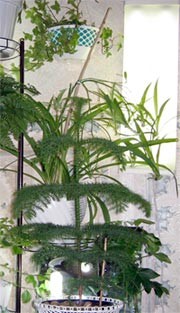 The use of artificial lighting sometimes happensjust necessary. Insufficient amount of light leads to the fact that the leaves become shallow, the formation of chlorophyll in them is disturbed or ceased, the plant is strongly stretched. If there is no way to provide the plant with natural light, then artificial light will have to be resorted to. Light bulbs have too many red, orange and infrared rays that accelerate vertical growth. Therefore, under incandescent bulbs, the plants are stretched, and the leaves can suffer from the evolved heat. Thus, incandescent lamps are best not to use. The fluorescent lamps are the most approximate in their spectrum to natural light. They can be purchased at any hardware store. The lamp should be placed about 15-30 cm from the flowering plants and 30-60 cm from the decorative deciduous. If the stems of the plants began to stretch, move the light source closer.
The use of artificial lighting sometimes happensjust necessary. Insufficient amount of light leads to the fact that the leaves become shallow, the formation of chlorophyll in them is disturbed or ceased, the plant is strongly stretched. If there is no way to provide the plant with natural light, then artificial light will have to be resorted to. Light bulbs have too many red, orange and infrared rays that accelerate vertical growth. Therefore, under incandescent bulbs, the plants are stretched, and the leaves can suffer from the evolved heat. Thus, incandescent lamps are best not to use. The fluorescent lamps are the most approximate in their spectrum to natural light. They can be purchased at any hardware store. The lamp should be placed about 15-30 cm from the flowering plants and 30-60 cm from the decorative deciduous. If the stems of the plants began to stretch, move the light source closer.




